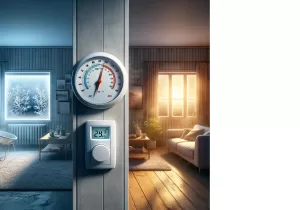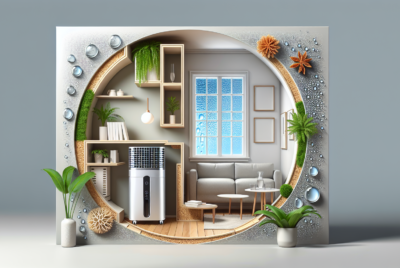How Temperature Affects Humidity Levels in Your Home
"We may earn a commission for purchases made using our links. Please see our disclosure to learn more."
Maintaining comfortable and healthy humidity levels in your home is crucial. This guide will delve into how temperature influences indoor humidity and offer easy-to-follow tips for achieving the perfect balance.
Understanding Humidity in Your Home
Humidity, a key aspect of indoor air quality, plays a vital role in your comfort. Let’s break down what relative humidity is and how we measure it.
Understanding humidity in your home is essential for maintaining a comfortable and healthy living environment.
What is Relative Humidity?
Relative humidity is the amount of moisture in the air compared to what the air can hold at a specific temperature. It’s expressed as a percentage. When the air holds all the moisture it can at a certain temperature, it’s at 100% relative humidity.
How Temperature Influences Indoor Humidity
Temperature and humidity are closely linked. Here’s how temperature affects indoor humidity:
- Warmer Air Holds More Moisture: As the temperature rises, the air can hold more water vapor. This means that on hot days, there’s potential for higher humidity levels.
- Cooler Air Holds Less Moisture: Conversely, cooler air can hold less moisture. This often results in lower humidity levels during colder months.

Measuring Indoor Humidity
To manage humidity levels, you first need to measure them. This can be done using a hygrometer, a device that measures the relative humidity in your home.
Ideal Humidity Levels
The ideal indoor humidity level varies, but it’s generally considered to be between 30% and 50%. Outside this range, you might experience various issues:
- Below 30%: Dry air can lead to respiratory problems, irritated skin, and increased static electricity.
- Above 50%: Excess moisture can promote the growth of mold, mildew, and dust mites, and can also make your home feel uncomfortably warm.
Tips for Maintaining Ideal Humidity Levels
- Use a Humidifier or Dehumidifier: Depending on your needs, these devices can either add or remove moisture from the air.
- Ventilation: Proper ventilation, especially in high-moisture areas like kitchens and bathrooms, can help regulate humidity.
- Houseplants: Some houseplants can naturally balance the humidity in your home by absorbing excess moisture.
- Monitor Temperature: Since temperature affects humidity, maintaining a consistent, comfortable temperature can indirectly help manage humidity levels.
- Regular Maintenance: Ensure that your heating, ventilation, and air conditioning (HVAC) systems are regularly serviced, as they play a significant role in regulating indoor humidity.
By understanding and managing the humidity levels in your home, you can create a more comfortable and healthier environment for you and your family.
Temperature’s Influence on Humidity
Understanding the relationship between temperature and humidity is crucial for maintaining a comfortable and healthy indoor environment. Here’s a closer look at how temperature influences humidity:
- Warmer Air and Increased Humidity: Warmer air has a greater capacity to hold moisture. As the temperature rises, the air can absorb more water vapor, leading to increased humidity levels. This is why humid days often feel hotter in the summer.
- Cooler Air and Reduced Humidity: Cooler air can hold less moisture. When temperatures drop, the air becomes less capable of retaining water vapor, often resulting in lower humidity levels. This is a common scenario in winter months, leading to drier indoor air.
- Condensation: When warm, moist air comes into contact with a cool surface, it can lead to condensation as the air cools and loses its ability to hold moisture. This is often seen on windows and walls in colder climates.
The Risks of High Indoor Humidity
High indoor humidity levels can create a variety of problems, impacting both the environment of your home and your health:
- Escalation of Pollutant Concentrations: Higher humidity can increase the concentration of certain pollutants, including volatile organic compounds (VOCs) and allergens.
- Mold and Mildew Growth: Moist environments are ideal for the growth of mold and mildew, which can damage your home and contribute to poor air quality.
- Dust Mites and Bacteria: High humidity fosters the growth of dust mites and bacteria, which can exacerbate allergies and respiratory problems.
- Health Risks: The combination of poor air quality, mold, dust mites, and bacteria can pose significant health risks, especially for individuals with asthma, allergies, or respiratory conditions.
- Comfort and Well-being: Excessively high humidity can make your living environment feel stuffy and uncomfortable, impacting overall well-being.
Managing indoor humidity levels is therefore important not just for comfort, but also for maintaining a healthy living environment. This often involves using dehumidifiers in humid climates, ensuring good ventilation, and monitoring indoor air quality regularly.




